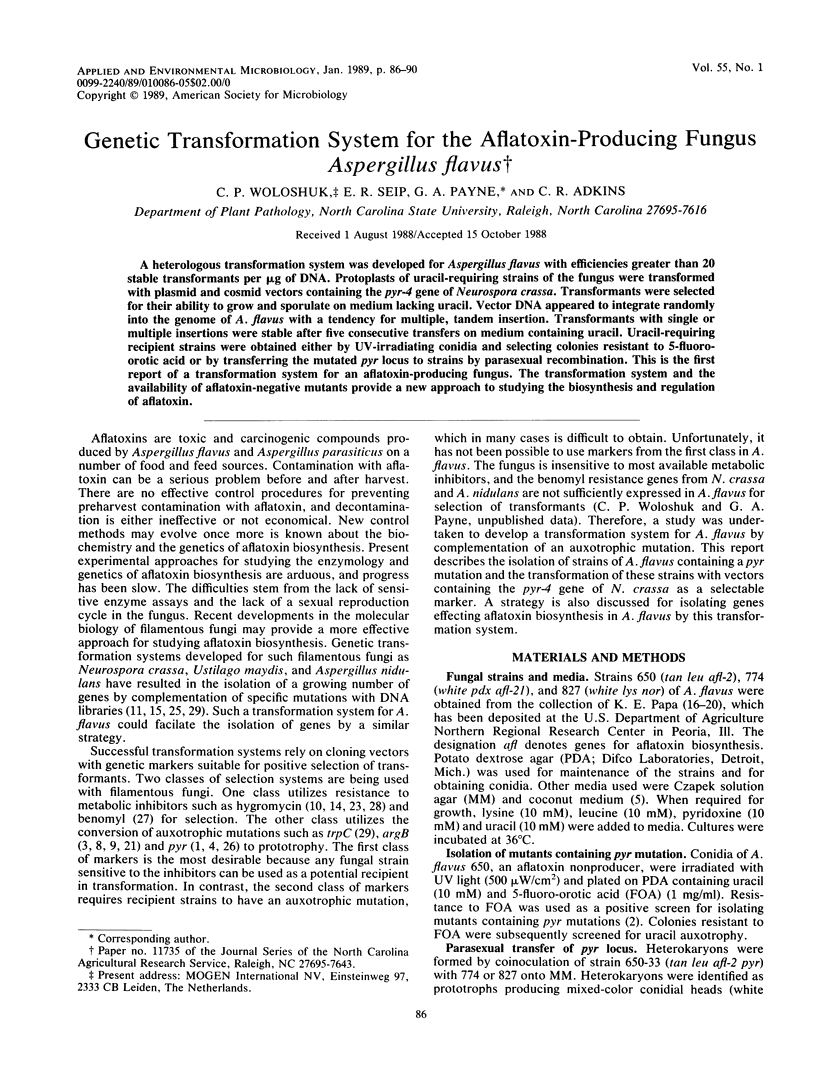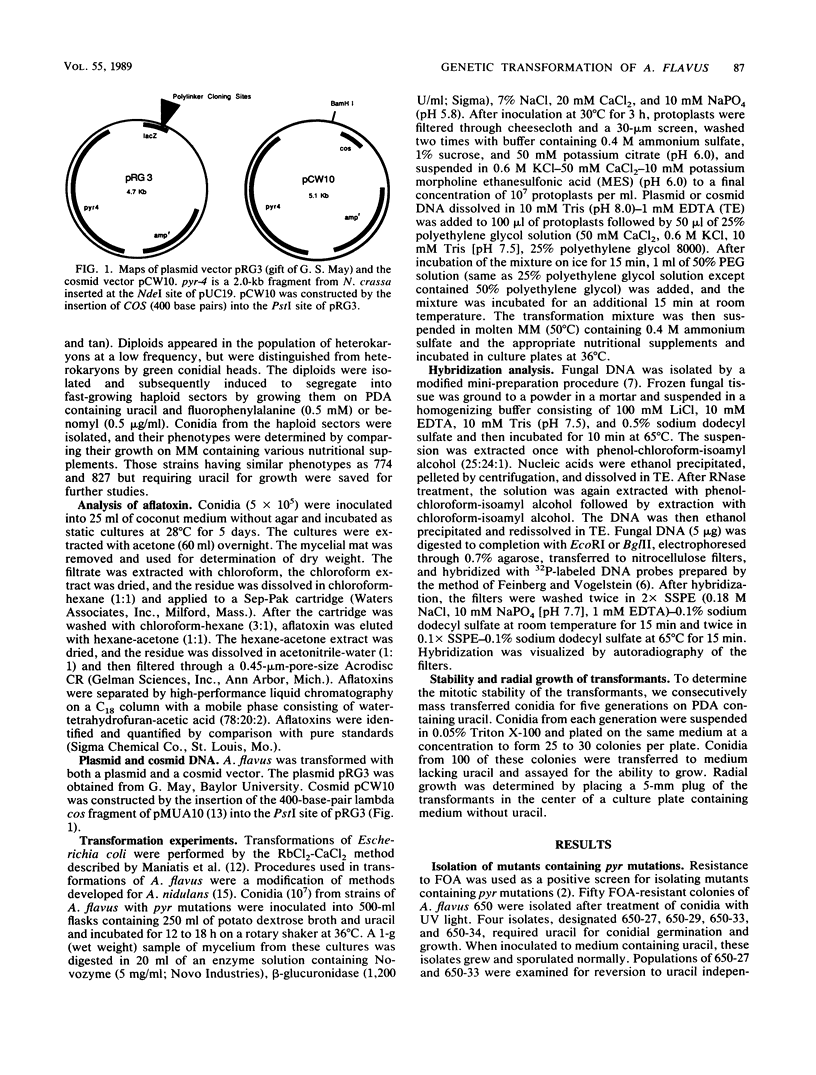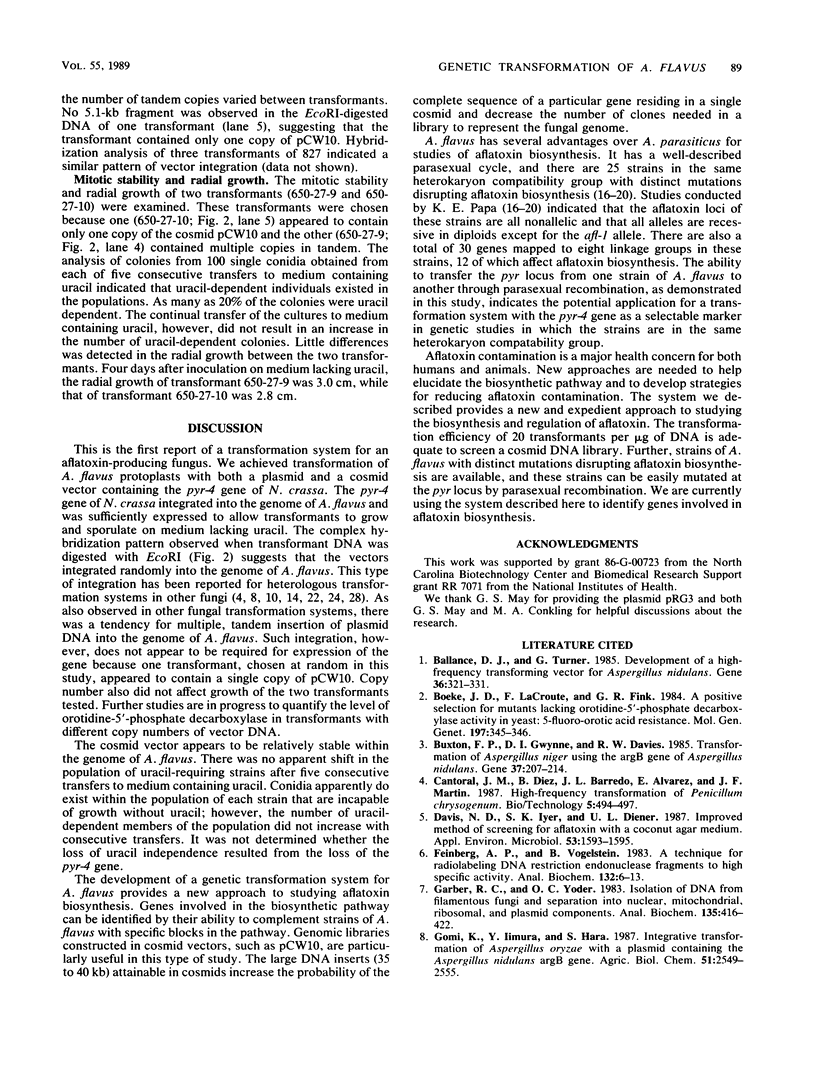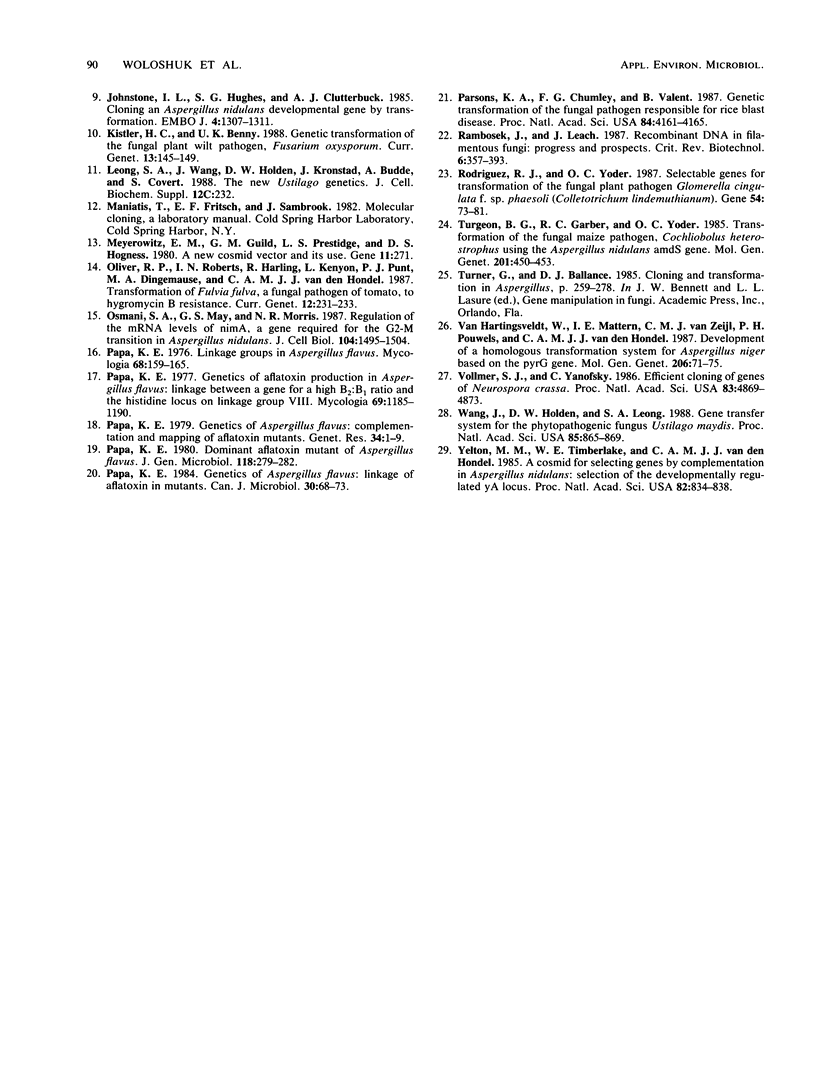Abstract
A heterologous transformation system was developed for Aspergillus flavus with efficiencies greater than 20 stable transformants per micrograms of DNA. Protoplasts of uracil-requiring strains of the fungus were transformed with plasmid and cosmid vectors containing the pyr-4 gene of Neurospora crassa. Transformants were selected for their ability to grow and sporulate on medium lacking uracil. Vector DNA appeared to integrate randomly into the genome of A. flavus with a tendency for multiple, tandem insertion. Transformants with single or multiple insertions were stable after five consecutive transfers on medium containing uracil. Uracil-requiring recipient strains were obtained either by UV-irradiating conidia and selecting colonies resistant to 5-fluoroorotic acid or by transferring the mutated pyr locus to strains by parasexual recombination. This is the first report of a transformation system for an aflatoxin-producing fungus. The transformation system and the availability of aflatoxin-negative mutants provide a new approach to studying the biosynthesis and regulation of aflatoxin.
Full text
PDF




Images in this article
Selected References
These references are in PubMed. This may not be the complete list of references from this article.
- Ballance D. J., Turner G. Development of a high-frequency transforming vector for Aspergillus nidulans. Gene. 1985;36(3):321–331. doi: 10.1016/0378-1119(85)90187-8. [DOI] [PubMed] [Google Scholar]
- Boeke J. D., LaCroute F., Fink G. R. A positive selection for mutants lacking orotidine-5'-phosphate decarboxylase activity in yeast: 5-fluoro-orotic acid resistance. Mol Gen Genet. 1984;197(2):345–346. doi: 10.1007/BF00330984. [DOI] [PubMed] [Google Scholar]
- Buxton F. P., Gwynne D. I., Davies R. W. Transformation of Aspergillus niger using the argB gene of Aspergillus nidulans. Gene. 1985;37(1-3):207–214. doi: 10.1016/0378-1119(85)90274-4. [DOI] [PubMed] [Google Scholar]
- Davis N. D., Iyer S. K., Diener U. L. Improved method of screening for aflatoxin with a coconut agar medium. Appl Environ Microbiol. 1987 Jul;53(7):1593–1595. doi: 10.1128/aem.53.7.1593-1595.1987. [DOI] [PMC free article] [PubMed] [Google Scholar]
- Feinberg A. P., Vogelstein B. A technique for radiolabeling DNA restriction endonuclease fragments to high specific activity. Anal Biochem. 1983 Jul 1;132(1):6–13. doi: 10.1016/0003-2697(83)90418-9. [DOI] [PubMed] [Google Scholar]
- Garber R. C., Yoder O. C. Isolation of DNA from filamentous fungi and separation into nuclear, mitochondrial, ribosomal, and plasmid components. Anal Biochem. 1983 Dec;135(2):416–422. doi: 10.1016/0003-2697(83)90704-2. [DOI] [PubMed] [Google Scholar]
- Johnstone I. L., Hughes S. G., Clutterbuck A. J. Cloning an Aspergillus nidulans developmental gene by transformation. EMBO J. 1985 May;4(5):1307–1311. doi: 10.1002/j.1460-2075.1985.tb03777.x. [DOI] [PMC free article] [PubMed] [Google Scholar]
- Meyerowitz E. M., Guild G. M., Prestidge L. S., Hogness D. S. A new high-capacity cosmid vector and its use. Gene. 1980 Nov;11(3-4):271–282. doi: 10.1016/0378-1119(80)90067-0. [DOI] [PubMed] [Google Scholar]
- Osmani S. A., May G. S., Morris N. R. Regulation of the mRNA levels of nimA, a gene required for the G2-M transition in Aspergillus nidulans. J Cell Biol. 1987 Jun;104(6):1495–1504. doi: 10.1083/jcb.104.6.1495. [DOI] [PMC free article] [PubMed] [Google Scholar]
- Papa K. E. Genetics of Aspergillus flavus: complementation and mapping of aflatoxin mutants. Genet Res. 1979 Aug;34(1):1–9. doi: 10.1017/s0016672300019236. [DOI] [PubMed] [Google Scholar]
- Papa K. E. Genetics of Aspergillus flavus: linkage of aflatoxin mutants. Can J Microbiol. 1984 Jan;30(1):68–73. doi: 10.1139/m84-012. [DOI] [PubMed] [Google Scholar]
- Papa K. E. Genetics of aflatoxin production in Aspergillus flavus: linkage between a gene for a high B2:B1 ratio and the histidine locus on linkage group VIII. Mycologia. 1977 Nov-Dec;69(6):1185–1190. [PubMed] [Google Scholar]
- Papa K. E. Linkage groups in Aspergillus flavus. Mycologia. 1976 Jan-Feb;68(1):159–165. [PubMed] [Google Scholar]
- Parsons K. A., Chumley F. G., Valent B. Genetic transformation of the fungal pathogen responsible for rice blast disease. Proc Natl Acad Sci U S A. 1987 Jun;84(12):4161–4165. doi: 10.1073/pnas.84.12.4161. [DOI] [PMC free article] [PubMed] [Google Scholar]
- Rambosek J., Leach J. Recombinant DNA in filamentous fungi: progress and prospects. Crit Rev Biotechnol. 1987;6(4):357–393. doi: 10.3109/07388558709089387. [DOI] [PubMed] [Google Scholar]
- Rodriguez R. J., Yoder O. C. Selectable genes for transformation of the fungal plant pathogen Glomerella cingulata f. sp. phaseoli (Colletotrichum lindemuthianum). Gene. 1987;54(1):73–81. doi: 10.1016/0378-1119(87)90349-0. [DOI] [PubMed] [Google Scholar]
- Vollmer S. J., Yanofsky C. Efficient cloning of genes of Neurospora crassa. Proc Natl Acad Sci U S A. 1986 Jul;83(13):4869–4873. doi: 10.1073/pnas.83.13.4869. [DOI] [PMC free article] [PubMed] [Google Scholar]
- Wang J., Holden D. W., Leong S. A. Gene transfer system for the phytopathogenic fungus Ustilago maydis. Proc Natl Acad Sci U S A. 1988 Feb;85(3):865–869. doi: 10.1073/pnas.85.3.865. [DOI] [PMC free article] [PubMed] [Google Scholar]
- Yelton M. M., Timberlake W. E., Hondel C. A. A cosmid for selecting genes by complementation in Aspergillus nidulans: Selection of the developmentally regulated yA locus. Proc Natl Acad Sci U S A. 1985 Feb;82(3):834–838. doi: 10.1073/pnas.82.3.834. [DOI] [PMC free article] [PubMed] [Google Scholar]
- van Hartingsveldt W., Mattern I. E., van Zeijl C. M., Pouwels P. H., van den Hondel C. A. Development of a homologous transformation system for Aspergillus niger based on the pyrG gene. Mol Gen Genet. 1987 Jan;206(1):71–75. doi: 10.1007/BF00326538. [DOI] [PubMed] [Google Scholar]



